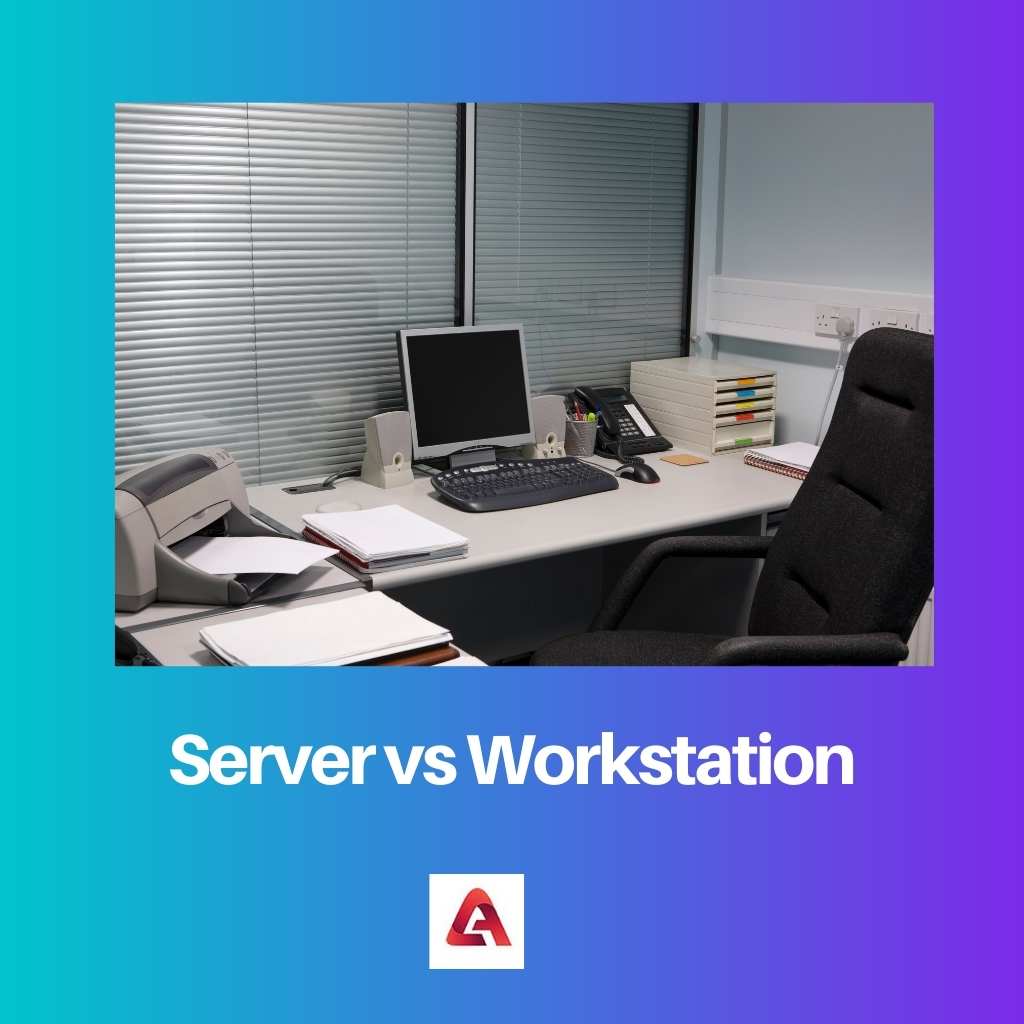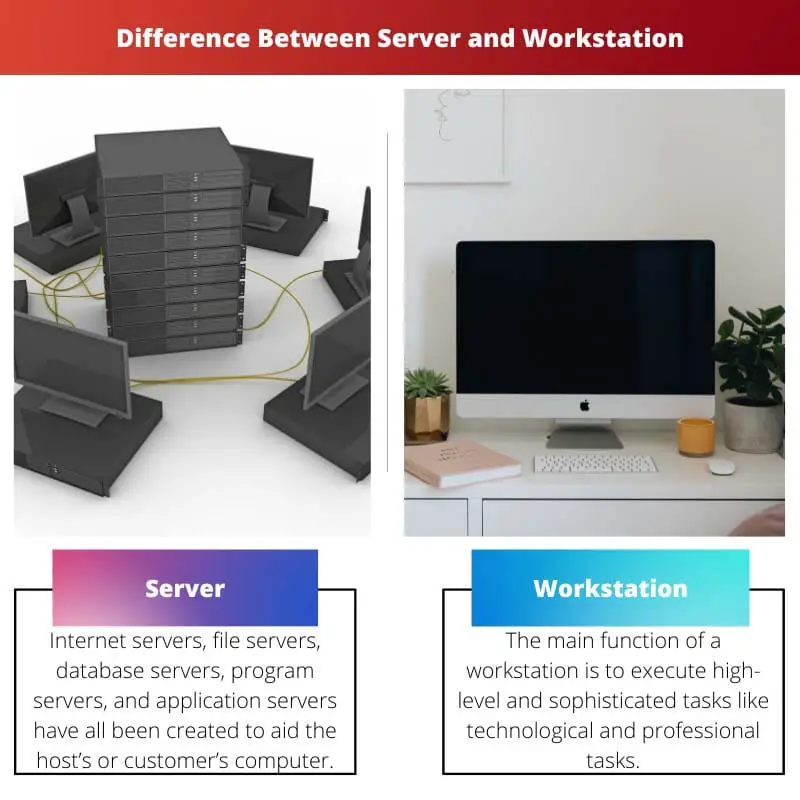Servers and workstations are two types of computing devices that are commonly seen in corporate environments. Servers have been used to store data as well as to host a variety of distinct functions between machines in multiple offices.
Workstations, on the other end, are high-end machines developed primarily for specific technological tasks.
Key Takeaways
- Servers are powerful computers designed to manage network resources, while workstations are high-performance computers designed for specialized tasks.
- Servers prioritize processing power, reliability, and stability, while workstations focus on performance and advanced hardware for specific applications.
- Servers support multiple users and devices simultaneously, whereas workstations are intended for single-user usage.
Server vs Workstation
A server is a computer designed to provide services or resources on a secured network. A workstation is a computer designed for individual use, for tasks such as word processing, web browsing, programming, graphic design, while optimizing for performance, user interaction, and user productivity.

A server is a piece of machinery or software that responds to client requests for services. It’s a web-based business. Since the Graphics User Interface is configurable to the servers, it can be pre-installed or not.
For example, a web server is a kind of server used to establish communication with clients with the help of the HTTP protocol.
A workstation is a machine that seeks LAN access and uses switch services to react to the demands and conduct specific tasks with increased features.
Workstation procedures include business, engineering, as well as graphical user interfaces, which are pre-installed because they are not just an optional component of the workstation.
Comparison Table
| Parameters of Comparison | Server | Workstation |
|---|---|---|
| Definition | Internet servers, file servers, database servers, program servers, and application servers have all been created to aid the host’s or customer’s computer. | The main function of a workstation is to execute high-level and sophisticated tasks like technological and professional tasks. |
| Comprise of | A server is made up of both hardware and software. It enables hosting devices to be connected to the very same system and connect relevant data. | Workstations employ network connections as well, although they are designed for distinct purposes. Also, they can transmit info with some other machines, but that is not their primary function. |
| Examples | Application servers, web servers, print servers, and file servers are examples of servers, which can be customized to meet the needs of users. | The workstation, on the other hand, is intended for multi-tasking. Graphic design, voice recording, film making, constructing, research, database administration, and computer programming are the most common applications. |
| Connected with | The server isn’t really linked to the screen. It’s attached to the keyboard. | A workstation is a complete system with all of the features of a home pc. |
| Location | The server is in a suitable location, such as a room or even a tower. | Workstations can be moved from one location to another. |
What is Server?
A server is a tangible computer that is dedicated to hosting or running one or maybe more services for consumers as well as other machines on a system. Print server, internet server, file server, and application server are all instances of servers.
It is a technology that is specifically built to execute multiple tasks for the clients or hosting server, as well as to fulfil their demands. For all of us, an internet browser served as a customer.
While we use HTML to look for anything on it, it retrieves data from the web browser.
They are found in a separate area known as the main server. They transmit data through a company’s network or even to the general public.
It is a company that deals with software, hardware, and other operating systems.
A server can be defined as a connecting network that provides data to multiple clients at the same time. The client/server approach is used on the World Wide Web, allowing multiple people to view websites from all over the world.

What is Workstation?
Workstation is a more specific phrase than servers. It is a type of computer or system that is intended for individual use. They are primarily designed to do high-level tasks such as analytical, technical, including tactical labour.
As a result, they come with plenty of RAM, cores, a potent graphics card, and swappable motherboards.
They can do things simultaneously. They vary from desktop computers in that they have superior efficiency and more advanced peripherals and components.
They can link to a local network as well. Various design works, application development, and architectural firms now use this arrangement to improve their work.
NASA (United States of America) created the workstation during the year 1981 for its aviation programs. It has been used extensively since 1983.
Workstations are mostly used in small technical, graphic arts, and architecture firms and organizations where a quicker microprocessor, a large amount of RAM, moderate computational capability, and elevated graphics have been demanded.
In today’s technology, the business setting entails connecting workstations to a local district network to pool resources with other computers.

Main Differences Between Server and Workstation
- Within a networking area, a server is a computer program or machine that stores files and administers system resources. A workstation, on the other hand, is a computer that offers extremely timely and efficient graphics, increased performance, increased scalability, and ISV accreditation.
- The server is responsible for internet-related tasks such as interacting with consumers, replying to their queries, and delivering the requested content to them. Workstations, on the other hand, are utilized in a wide range of corporate applications, including online content production, technical computer-aided designing, architectural features, and comprehensive analysis.
- FTP, web, applications, mail, proxies, telnet services, and more types of servers are available. There seem to be visual, sound, and CAD/CAM workstations, for instance, that are specifically intended for that task.
- Servers use the Linux, Windows, and Solaris computer systems, whereas workstations, on the other hand, use Unix, Linux, and Windows NT. Workstations make use of specialized application software by ISVs (Independent Software Vendors) and are designed exclusively for workstations.
- The Graphics User Interface (GUI) is required on workstations but not required on servers.
